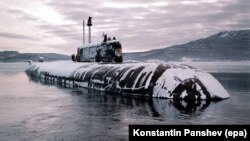WASHINGTON -- Some two years ago, Western intelligence and military experts scrambled to make sense of a strange new Russian weapon whose designs were glimpsed briefly in a mysterious report on Russian state TV.
The weapon was a nuclear-capable underwater drone that would be launched from a submarine. The description accompanying a picture of the drone said such vehicles or weapons would be pilotless and capable of attacking enemies and creating "zones of extensive radioactive contamination unfit for military, economic or other activity for a long period of time."
At the time, in November 2015, a Kremlin spokesman said the document was shown mistakenly in the state TV report. But the spokesman also made no effort to dispute or deny plans for such a weapon, and analysts concluded it was an intentional signal being sent by the Kremlin.
Now, for the first time there are public indications that U.S. intelligence have not only confirmed Russian intentions for the weapon, but are also trying to figure out how to respond to it.
The indications came in a draft of the U.S. Nuclear Posture Review, a document crafted by the Defense Department every four years laying out the circumstances under which the United States will use nuclear weapons.
The 64-page draft, first published by HuffPost earlier this month, stated that the document is "pre-decisional," indicating that it is still being debated by the Pentagon and other national security agencies.
In a section concerning Russia, the document references Moscow's well-known and ongoing efforts to modernize its nuclear arsenal, something that has been a priority of President Vladimir Putin for years.
"Russia is also developing at least two new intercontinental range systems, a hypersonic glide vehicle, and a new intercontinental, nuclear-armed, undersea autonomous torpedo," the document said.
That appears to refer to the underwater drone, which was dubbed Status-6 in November 2015 when Russian TV gave a first glimpse of the plans.
Western analysts have said that if such a weapon were deployed and actually detonated off the U.S. East Coast, for example, it would shower radioactivity on major cities and render huge swaths of territory uninhabitable. Some have called it a "doomsday machine" because of the indiscriminate destruction it would wreak.
Analysts and arms experts in Washington and elsewhere have confirmed the authenticity of the document, known also as the NPR, while also emphasizing its “pre-decisional” nature. The Pentagon has declined to comment.The strategy is expected to be formally released before the end of January, and President Donald Trump must give final approval.
Dmitry Gorenburg, a Russian military specialist at the Center for Naval Analyses in Washington, D.C., said the mention of the underwater drone in the NPR was a confirmation that the Russians indeed were considering such a weapon.
"In terms of why they want to have something like that, my best guess is it's a response to our missile defenses…eliminating their second-strike ability,” he told RFE/RL. That refers to the ability of a nuclear-armed country to be attacked with nuclear weapons, and retain enough capacity to retaliate, with something like intercontinental ballistic missiles, or ICBMs.
The Russians "want to highlight to U.S. nuclear planners that 'hey, just because you think you’ll have the ability to take out all the ICBMs… we have other things'," Gorenburg said. “'You might be able to take out our missiles, but you won’t be able to take out this thing.'"
In addition to confirming Russian plans for the weapons, the Nuclear Posture Review also lays out plans to build other new, nuclear weapons, including two that would be put on submarines or surface ships.
It also calls for the development of new,"low-yield" nuclear weapons — warheads that have a smaller explosive force than those typically found on missiles.
Arms control experts have warned that small nuclear weapons could end up making a nuclear confrontation more likely.












